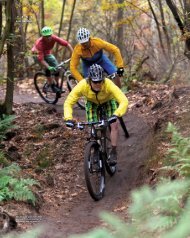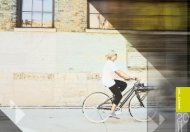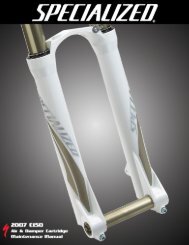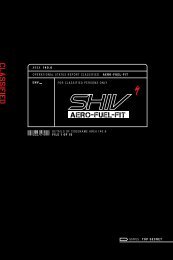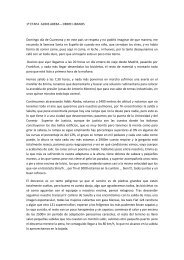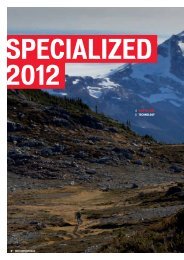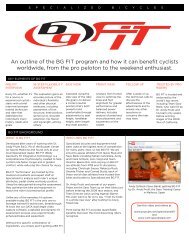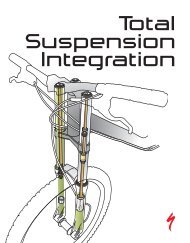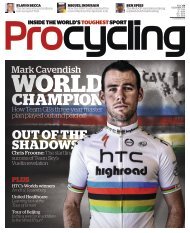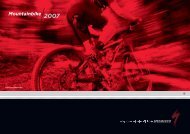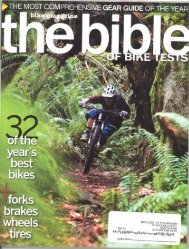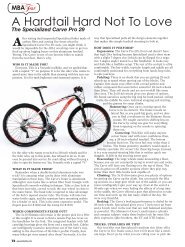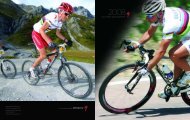endurance bike test - Specialized Bicycles
endurance bike test - Specialized Bicycles
endurance bike test - Specialized Bicycles
You also want an ePaper? Increase the reach of your titles
YUMPU automatically turns print PDFs into web optimized ePapers that Google loves.
TECH & TRAINING » <strong>endurance</strong> <strong>bike</strong> <strong>test</strong><br />
<strong>Specialized</strong> S-Works<br />
Roubaix<br />
SL4<br />
By Logan VonBokel<br />
$8,000<br />
14.31 lbs<br />
56cm<br />
BY THE NUMBERS<br />
user friendliness<br />
VALUE<br />
RIDE: 24/30<br />
LAB: 33/40<br />
weight<br />
COMFORT<br />
7<br />
Scientific Testing: 33 of 40 points<br />
The Roubaix SL4 did not perform as well as its<br />
predecessor, the SL3, in our vibration <strong>test</strong>. It blew<br />
that <strong>test</strong> away in 2011. But the change isn’t all that<br />
surprising; <strong>Specialized</strong> freely admits that it has<br />
hardened up the SL4, making it more of a race <strong>bike</strong><br />
and sacrificing a bit of comfort. In this round, the<br />
8<br />
total score<br />
80 /100<br />
10<br />
10<br />
15<br />
8<br />
10 ACCELERATION<br />
10 HANDLING<br />
10<br />
20 13<br />
TORSIONAL STIFFNESS<br />
20 VIBRATION DAMPING<br />
20<br />
5 5 “Racer’s heads should turn in interest.”<br />
The Roubaix SL4 had the launch of the year during the 2012 season. In it’s worldwide debut, under Tom<br />
Boonen at Paris-Roubaix, the <strong>bike</strong> rode away from all comers on the cobbles of northern France, looping<br />
around the fabled Roubaix velodrome minutes ahead of its nearest competitor. Boonen’s 54km solo move<br />
was like an hour long <strong>Specialized</strong> commercial. For a bicycle manufacturer, it doesn’t get any better than that.<br />
What separates the Roubaix SL4 from its predecessors is a distinct move towards the racer. This is no<br />
longer <strong>Specialized</strong>’s “old-man <strong>bike</strong>”; the SL4 is fast — very fast.<br />
9<br />
Roubaix finished behind the very soft Volagi Liscio<br />
and Trek’s new Domane design.<br />
The running between the Roubaix and Domane<br />
was close, though, making it all the more impressive<br />
that the SL4 is the third-stiffest <strong>bike</strong> to ever go<br />
through the VeloLab, falling short of only the phenomenal<br />
Cannondale SuperSix EVO and the Focus<br />
Izalco. That an “<strong>endurance</strong> <strong>bike</strong>” is one of the<br />
stiffest <strong>bike</strong>s we’ve <strong>test</strong>ed adds a certain amount of<br />
credibility to the <strong>endurance</strong> segment. Racer’s heads<br />
should turn in interest.<br />
Subjective Ride Quality: 24 of 30 points<br />
In the real world, we have to ride on roads that are<br />
not always pristine — it’s those flawed roads, in fact,<br />
that these <strong>bike</strong>s are designed for. The overall torsional<br />
stiffness displayed by the Roubaix wouldn’t<br />
normally bode well for comfort. But the Roubaix<br />
floats. The front and rear ends are balanced in shock<br />
absorption, with neither proving to be overly harsh<br />
or soft.<br />
The new, innovative seatpost featured on the<br />
SL4, humorously dubbed the Cobl Gobl-R, adds a<br />
dose of comfort out back. For what it lacks in visual<br />
appeal, the oddly shaped Gobl-R makes up for by<br />
smoothing out road vibrations. The curving head<br />
of the Gobl-R acts as a leaf spring. Those who run<br />
more saddle setback will see even more of an advantage;<br />
they’ll effectively be lengthening the lever of<br />
the spring, making the movement of the Gobl-R<br />
more fluid and less bouncy.<br />
Acceleration on the SL4 is outstanding, a product<br />
of the frame’s torsional stiffness. The use of a stout<br />
stem and stiff bars help here as well, as does the inclusion<br />
of light carbon clincher wheels. But most of<br />
the get-up-and-go attitude can be attributed to the<br />
frame itself.<br />
Handling is equally excellent, if the fit is right.<br />
We gave the Roubaix 9 out of 10 available points in<br />
this category, but did so under the assumption that<br />
the fit will work for potential buyers. That isn’t a<br />
foregone conclusion, and may keep some more aggressive<br />
riders off the <strong>bike</strong>. We were forced to use<br />
a -17 degree, 120mm stem in order to achieve the<br />
desired position. Once there, the SL4 proved every<br />
bit as capable as the Roubaix SL3 that won our last<br />
<strong>endurance</strong> road roundup. It has a low trail figure,<br />
just 56mm, but a long wheelbase. The combination<br />
is one that seems to find a good balance between<br />
flickable steering and stability.<br />
User Friendliness: 8 of 10 points<br />
<strong>Specialized</strong> doesn’t skimp where it really matters:<br />
wheels, tires, and contact points. The stock tires<br />
are fat 25mm clinchers, mounted up to slick Roval<br />
carbon clincher rims. As usual, we took off a few<br />
points for the inclusion of pain-in-the-arse internal<br />
cable routing, but that’s the Roubaix’s only real userexperience<br />
flaw.<br />
Value: 10 of 15 points<br />
At $8,000, the Roubaix is the most expensive <strong>bike</strong><br />
in this <strong>test</strong>, and though it does come stock with carbon<br />
wheels and a top-tier Red group, that’s a lot to<br />
spend — particularly with the nearly-as-good Trek<br />
available for $1,000 less.<br />
brad kaminski<br />
70 VELO may 2013 velonews.com
TECH & TRAINING » <strong>endurance</strong> <strong>bike</strong> <strong>test</strong><br />
RESULTS<br />
For the second time in three years, the <strong>Specialized</strong> Roubaix takes top honors.<br />
However, the la<strong>test</strong> version of the <strong>bike</strong> that has won four of the last<br />
five editions of Paris-Roubaix comes at victory from a new angle. In 2011,<br />
it was vastly superior to all comers in the vibration damping <strong>test</strong>, in addition<br />
to its excellent stiffness scores. For 2013, the Roubaix has been firmed up<br />
and made into a race-day star at the expense of a bit of comfort. Both the<br />
Domane and the Liscio performed better in the vibration <strong>test</strong>.<br />
The new Roubaix’s stiffness figures are astounding. It is the third stiffest<br />
frame we’ve ever <strong>test</strong>ed, behind the race-bred Cannondale SuperSix EVO<br />
and the similarly hard-nosed Focus Izalco. It is, without question, a race<br />
<strong>bike</strong>. And yet it fell only slightly behind the Domane in the vibration <strong>test</strong>ing,<br />
proving its versatility. For the rider looking to maximize performance while<br />
taking the edge off of everything from chip-sealed pavement to dirt roads,<br />
the Roubaix is the clear choice.<br />
Trek’s Domane is a close second. It is more comfortable than the Roubaix,<br />
particularly in the rear — the difference was noticeable on the road, and<br />
that was backed up by the lab results. The IsoSpeed coupler is particularly<br />
adept at removing small vibrations, but also works quite well on the rutted,<br />
washboard-laden dirt roads that surround Velo’s Boulder office. While not as<br />
stiff as the Roubaix, Trek has still created a frame that stacks up well against<br />
some of the best race <strong>bike</strong>s we’ve <strong>test</strong>ed.<br />
In another <strong>test</strong>, the Volagi Liscio may have been victorious. It is, without<br />
question, the most comfortable <strong>bike</strong> in this roundup. The company’s patented<br />
LongBow stays effectively remove small vibrations and jarring hits<br />
more effectively than both the Roubaix and the Domane. The ride is buttery<br />
smooth, the geometry is spot on, and the disc brakes are phenomenal. The<br />
Volagi simply can’t compete in stiffness, though. It’s one of the sof<strong>test</strong> <strong>bike</strong>s<br />
we’ve ever passed through the lab, and the lack of rigidity is noticeable out on<br />
the road. Yank on the bars at full gallop and the front end sways to and fro as<br />
if it’s being buffeted by hidden winds; throw in a sprint and the rear end feels<br />
disconnected from the front. The Liscio is no race <strong>bike</strong> — but then again, it<br />
doesn’t pretend to be. For the more casual rider looking only for a bit of offasphalt<br />
adventure or a comfortable ride for the long haul, look no further. The<br />
Liscio has the chops to get you just about anywhere in comfort.<br />
Look forgoes the use of proprietary comfort-providing tech: no IsoSpeed,<br />
no LongBow stays, no Zertz. It’s a classic <strong>endurance</strong> frame, featuring a tall<br />
head tube and slimmed stays. It <strong>test</strong>ed well, but not excellently, on the torsional<br />
stiffness jig, and we could find no great fault with its stiffness levels<br />
out on the road. Likewise, its rear end came within spitting distance of the<br />
Roubaix on the large bumps — a difference of only .04g — but couldn’t<br />
quite close the gap, and fell well behind overall. We appreciate the Look’s<br />
unique visual presence, though. Despite its tall head tube, the <strong>bike</strong> pulls off<br />
a streamlined appearance, absent of the “begging dog” look so common on<br />
<strong>endurance</strong> <strong>bike</strong>s with tall head tubes.<br />
THE FINAL<br />
TALLY<br />
72<br />
LOOK<br />
VOLAGI<br />
TREK<br />
SPECIALIZED<br />
USER<br />
FRIENDLINESS<br />
VELO may 2013 velonews.com<br />
TORSIONAL STIFFNESS RESULTS<br />
overall deflection (lower values are stiffer)<br />
4.95<br />
5.46<br />
TORSIONAL<br />
STIFFNESS<br />
3.56<br />
4.52<br />
5.21mm<br />
100lbs<br />
pushing<br />
down<br />
6.53mm<br />
6.83mm<br />
.812<br />
.889<br />
1.06<br />
1.32<br />
.686<br />
.838<br />
.990<br />
8.15mm<br />
Deflection in mm<br />
COMFORT<br />
5 6 6 7 3 14<br />
11<br />
100<br />
13VALUE<br />
ACCELERATION<br />
HANDLING<br />
WEIGHT<br />
VIBRATION<br />
DAMPING<br />
7 13 10 4 5 2 9 20<br />
8 12<br />
The torsional stiffness <strong>test</strong><br />
we co-developed with<br />
Microbac Laboratories,<br />
Inc. measures how a<br />
<strong>bike</strong> moves at three<br />
different points<br />
while subjected to a<br />
simulated pedaling force.<br />
Here’s how it works.<br />
The front fork was<br />
fixed. The rear<br />
dropouts were<br />
mounted to a<br />
dummy axle that<br />
pivots on an eyebolt, allowing the rear of the bicycle to twist and move laterally. A chain<br />
was connected from the large chainring to the dummy rear axle to transfer the pedaling<br />
force through the rear triangle.<br />
Dial indicators contacted the <strong>bike</strong> at the center of the drive crankarm’s face, at the<br />
top of the head tube, and at the top of the seat tube. Two 50-pound dumbbell weights<br />
were hung on a spindle screwed into the left crank positioned horizontally forward and<br />
the values were recorded on the three dial indicators. — LENNARD ZINN<br />
65<br />
70<br />
8 7 8 4 15 14<br />
8 10 7 8 9 5 20 13<br />
76<br />
80<br />
1.63<br />
100<br />
100<br />
100



